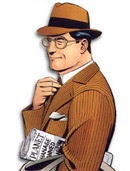 Los Angeles Times Publisher David Hiller ResignsHiller's 21-month tenure was marked by plans for the sharpest staff and production cuts in The Times' history. No successor is named.
Los Angeles Times Publisher David Hiller ResignsHiller's 21-month tenure was marked by plans for the sharpest staff and production cuts in The Times' history. No successor is named.
By Michael A. Hiltzik Los Angeles Times Staff Writer
July 15, 2008
Los Angeles Times Publisher
David D. Hiller resigned Monday after a 21-month tenure that encompassed the departures of two Times editors and plans for the sharpest staff and production cuts in the newspaper's history amid a continuing slide in advertising revenue.
Tribune Co. -- which owns The Times and other media assets, including the Chicago Tribune and KTLA-TV Channel 5, as well as the Chicago Cubs baseball team -- named no successor to Hiller.
Although newspapers across the country have been suffering severe revenue declines, The Times' performance under Hiller has been particularly disappointing. The paper has experienced the steepest drop in cash flow of any in the Tribune chain of 11 daily newspapers. Hiller also acquired a reputation among Tribune brass as an indecisive leader, according to senior Times executives; The Times has been without an advertising manager since February, for example.
Responding to the criticism of his management style, Hiller said, "It's fair to say that along with our colleagues here, we tried to make the decisions that were best for the paper."
A statement he e-mailed to Times staff suggested that he was ousted by Tribune Chairman and Chief Executive Sam Zell: "Sam's the boss and he gets to pick his own quarterback."
Tribune Chief Operating Officer Randy Michaels said he expected to name a new publisher by the end of the summer. In the interim, he said, he would oversee operations at The Times in tandem with Tribune Executive Vice President and Chief Administrative Officer Gerry Spector.
Hiller's departure came the day Times managers began implementing a newsroom cutback of 150 people, part of a paperwide reduction of 250. The newsroom layoffs represent about 17% of the editorial staff at the newspaper and its website.
The cuts were ordered in an effort to husband the newspaper's cash flow in an environment of declining advertising revenue, but they have triggered a debate -- similar to that raging throughout the newspaper industry -- over how they might affect the newspaper's ability to serve the community.
"The overall picture of what's happening to The Times is simply not good," said George Kieffer, a prominent Los Angeles attorney who has expressed concerns in the past about the effect of cutbacks on the newspaper's civic role.
"There has never been a time when Greater Los Angeles has been more in need of civic education, the central role of The Times," he said.
The announcement of Hiller's departure came the same day as the resignation of
Ann Marie Lipinski, 52, as editor of the Chicago Tribune.
Lipinski will be replaced by
Gerould W. Kern, 58, a former associate and deputy managing editor at the newspaper who has been vice president of editorial at the company's Tribune Publishing unit since 2003.
Lipinski said her last day at the newspaper would be Thursday. Her departure comes scarcely a week after the Chicago paper announced deep cuts in its staffing and number of weekly pages. But in a memo to her staff excerpted in the newspaper, she said of her decision to leave after seven years as editor that "it would be inaccurate to attribute it to any one event."
[Click for MORE]
Sphere: Related Content
 100 empty, black chairs, adorned with "pink slips," outside Tribune Co.'s Baltimore Sun symbolize the editorial staffers being terminated in yet another budget cut. [Click for MORE]
100 empty, black chairs, adorned with "pink slips," outside Tribune Co.'s Baltimore Sun symbolize the editorial staffers being terminated in yet another budget cut. [Click for MORE]







